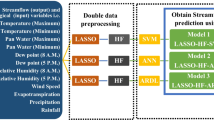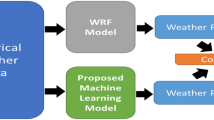Abstract
The data-driven forecasting methods/models usually face two important tasks: one is to effectively deal with the uncertainties and/or noise in the data for improving the accuracy, another is to increase the models’ interpretability. In order to realize these two objectives, this study presents one novel double-input rule modules (DIRMs) stacked deep interval type-2 fuzzy model (DIT2FM) for forecasting applications. Firstly, the stacked structure of the proposed deep fuzzy model, abbreviated as IT2DIRM-DFM, is presented. This deep fuzzy model is constructed by stacking the interval type-2 fuzzy sets-based double-input rule modules (IT2DIRMs). It can not only efficiently handle high levels of uncertainties exited in the observed data by the type-2 fuzzy scheme, but also has better interpretable ability than the conventional deep models through clearly observing which rules are fired and how the fired degrees are. Then, the data-driven learning strategy for the IT2DIRM-DFM is proposed. In the proposed learning strategy, the data generation processes for all the stacked layers and the constrained least square method based design of the DIRMs are presented in detail. Finally, the proposed model is successfully applied to two real-world forecasting applications, and comparison results with the other forecasting models are also given. Both the statistical analysis and the experimental comparisons validate the superiorities of the proposed model over the other comparative models.















Similar content being viewed by others
References
Srivastava, A., Pandey, A.S., Singh, D.: Short-term load forecasting methods: A review. In: 2016 International Conference on Emerging Trends in Electrical Electronics & Sustainable Energy Systems (ICETEESES), pp. 130–138, IEEE (2016)
Peng, H., Wang, H., Du, B., Bhuiyan, M.Z.A., Ma, H., Liu, J., Philip, S.Y.: Spatial temporal incidence dynamic graph neural networks for traffic flow forecasting. Inf. Sci. 521, 277–290 (2020)
Kong, X., Li, C., Wang, C., Zhang, Y., Zhang, J.: Short-term electrical load forecasting based on error correction using dynamic mode decomposition. Appl. Energy 261, 114368 (2020)
Vasiliy, O., Victor, N., Nataly, Z., Dmitriy, M.: Urban traffic flows forecasting by recurrent neural networks with spiral structures of layers. Neural Comput. Appl. 32, 1–13 (2020)
Box, G.E., David, A.P.: Distribution of residual autocorrelations in autoregressive-integrated moving average time series models. J. Am. Stat. Assoc. 65(332), 1509–1526 (1970)
Box, G.E., Gwilym, M.J., Gregory, C.R.: Time Series Analysis: Forecasting and Control. Wiley, Hoboken (2015)
Lai, Y., David, A.D.: Use of the autoregressive integrated moving average (arima) model to forecast near-term regional temperature and precipitation. Weather Forecast. 35(3), 959–976 (2020)
Chu, Y., Urauhart, B., Gohari, S.M.: Short-term reforecasting of power output from a 48mwe solar pv plant. Sol. Energy 112, 68–77 (2015)
Sarwar, R., Cho, H., Cox, S.J., Mago, P.J., Rogelio, L.: Field validation study of a time and temperature indexed autoregressive with exogenous (arx) model for building thermal load prediction. Energy 119, 483–496 (2017)
Bata, M.T.H., Rupp, C., David, S.K.T.: Short-term water demand forecasting using nonlinear autoregressive artificial neural networks. J. Water Res. Plan. Manag. 146(3), 04020008 (2020)
Johansen, S.: Estimation and hypothesis testing of cointegration vectors in gaussian vector autoregressive models. Econometrica 59, 1551–1580 (1991)
Melnyk, I., Arindam, B.: Estimating structured vector autoregressive models. Int. Conf. Mach. Learn. 121, 1–7 (2016)
Qiu, H., Xu, S., Han, F., Liu, H., Caffo, B.: Robust estimation of transition matrices in high dimensional heavy-tailed vector autoregressive processes. In: Proceedings of the 32nd International Conference on Machine Learning
Rodríguez, F., Fleetwood, A., Galarza, A., Fontán, L.: Predicting solar energy generation through artificial neural networks using weather forecasts for microgrid control. Renew. Energy 126, 855–864 (2018)
Cervone, G., Laura, C.-H., Stefano, A., Luca, D.M.: Short-term photovoltaic power forecasting using artificial neural networks and an analog ensemble. Renew. Energy 108, 274–286 (2017)
Li, R., Chen, X., Balezentis, T., Streimikiene, D., Niu, Z.: Multistep least squares support vector machine modeling approach for forecasting short-term electricity demand with application. Neural Comput. Appl. 21(1), 1–20 (2020)
Zhou, Y., Zhou, N., Gong, L., Jiang, M.: Prediction of photovoltaic power output based on similar day analysis, genetic algorithm and extreme learning machine. Energy 21(5), 117894 (2020)
Wang, H., Yi, H., Peng, J., Wang, G., Liu, Y., Jiang, H., Liu, W.: Deterministic and probabilistic forecasting of photovoltaic power based on deep convolutional neural network. Energy Convers. Manage. 153, 409–422 (2017)
Wang, K., Qi, X., Liu, H.: Photovoltaic power forecasting based lstm-convolutional network. Energy 189(2), 116225 (2019)
Chae, Y.T., Horesh, R., Hwang, Y., Lee, Y.M.: Artificial neural network model for forecasting sub-hourly electricity usage in commercial buildings. Energy Build. 111, 184–194 (2016)
Jahangir, H., Hanif, T., Sina, B., Ali, A., Ali, E., Aliakbar, G.M., Castilla, M.: A novel electricity price forecasting approach based on dimension reduction strategy and rough artificial neural networks. IEEE Trans. Ind. Inf. 16(4), 2369–2381 (2019)
Li, C., Yi, J., Wang, H., Zhang, G., Li, J.: Interval data driven construction of shadowed sets with application to linguistic word modelling. Inf. Sci. 507, 503–521 (2020)
Anh, N., Suresh, S., Pratama, M., Srikanth, N.: Interval prediction of wave energy characteristics using meta-cognitive interval type-2 fuzzy inference system. Knowl.-Based Syst. 169, 28–38 (2019)
Li, J., Liu, Z., Li, C., Zhixin, Z.: Improved artificial immune system algorithm for type-2 fuzzy flexible job shop scheduling problem. IEEE Trans. Fuzzy Syst. 53, 1–1 (2020)
Yi, J., Naoyoshi, Y., Kaoru, H.: Upswing and stabilization control of inverted pendulum system based on the sirms dynamically connected fuzzy inference model. Fuzzy Sets Syst. 122(1), 139–152 (2001)
Seki, H., Hiroaki, I., Masaharu, M.: On the generalization of single input rule modules connected type fuzzy reasoning method. IEEE Trans. Fuzzy Syst. 16(5), 1180–1184 (2008)
Li, C., Yi, J.: Sirms based interval type-2 fuzzy inference systems: properties and application. Int. J. Innov. Comput. Inf. Control 6(9), 4019–4028 (2010)
Li, C., Gao, J., Yi, J., Zhang, G.: Analysis and design of functionally weighted single-input-rule-modules connected fuzzy inference systems. IEEE Trans. Fuzzy Syst. 26(1), 56–71 (2016)
Li, C., Zhou, C., Peng, W., Lv, Y., Luo, X.: Accurate prediction of short-term photovoltaic power generation via a novel double-input-rule-modules stacked deep fuzzy method. Energy 11(7), 118700 (2020)
Castillo, O., Melin, P., Ontiveros, E., Peraza, C., Ochoa, P., Valdez, F., Soria, J.: A high-speed interval type 2 fuzzy system approach for dynamic parameter adaptation in metaheuristics. Eng. Appl. Artif. Intell. 85, 666–680 (2019)
Castillo, O.: Interval type-2 fuzzy dynamic parameter adaptation in bee colony optimization for autonomous mobile robot navigation. Recent Dev New Direction Soft-Comput. Found. Appl. 85, 45–62 (2020)
Ontiveros-Robles, E., Melin, P.: A hybrid design of shadowed type-2 fuzzy inference systems applied in diagnosis problems. Eng. Appl. Artif. Intell. 86, 43–55 (2019)
Ontiveros-Robles, E., Melin, P.: Toward a development of general type-2 fuzzy classifiers applied in diagnosis problems through embedded type-1 fuzzy classifiers. Soft. Comput. 24(1), 83–99 (2020)
Pal, S.S., Kar, S.: A hybridized forecasting method based on weight adjustment of neural network using generalized type-2 fuzzy set. Int. J. Fuzzy Syst. 21(1), 308–320 (2019)
Soto, J., Castillo, O., Melin, P., Pedrycz, W.: A new approach to multiple time series prediction using mimo fuzzy aggregation models with modular neural networks. Int. J. Fuzzy Syst. 21(5), 1629–1648 (2019)
Wu, X., Han, H., Liu, Z., Qiao, J.: Data-knowledge-based fuzzy neural network for nonlinear system identification. IEEE Trans. Fuzzy Syst. 28(9), 2209–2221 (2020)
Han, H., Li, J., Wu, X., Qiao, J.: Cooperative strategy for constructing interval type-2 fuzzy neural network. Neurocomputing 365(6), 249–260 (2019)
Han, H., Liu, H., Liu, Z., Qiao, J.: Fault detection of sludge bulking using a self-organizing type-2 fuzzy-neural-network. Control. Eng. Pract. 90, 27–37 (2019)
Jang, J.-S.: Anfis adaptive-network-based fuzzy inference system. IEEE Trans. Syst. Man Cybern. 23(3), 665–685 (1993)
Vincent, P., Larochelle, H., Lajoie, I., Bengio, Y., Manzagol, P.A., Bottou, L.: Stacked denoising autoencoders learning useful representations in a deep network with a local denoising criterion. J. Mach. Learn. Res. 11(12), 371–408 (2010)
Wang, L.: Fast training algorithms for deep convolutional fuzzy systems with application to stock index prediction. IEEE Trans. Fuzzy Syst. 28(7), 1301–1314 (2020)
Wu, D.: Approaches for reducing the computational cost of interval type-2 fuzzy logic systems. Overview and comparisons. IEEE Trans. Fuzzy Syst. 21(1), 80–99 (2012)
Wu, D., Woei, W.T.: Genetic learning and performance evaluation of type-2 fuzzy logic controllers. Eng. Appl. Artif. Intell. 19(8), 829–841 (2006)
Wu, D., Woei, W.T.: A simplified type-2 fuzzy controller for real-time control. ISA Trans. 15(4), 503–516 (2006)
Peng, W., Li, C., Zhang, G., Yi, J.: Interval type-2 fuzzy logic based transmission power allocation strategy for lifetime maximization of wsns. Eng. Appl. Artif. Intell. 87(6), 103269 (2020)
Wu, D., Mendel, J.M.: Recommendations on designing practical interval type-2 fuzzy systems. Eng. Appl. Artif. Intell. 85, 182–193 (2019)
Mendel, J.M.: On km algorithms for solving type-2 fuzzy set problems. IEEE Trans. Fuzzy Syst. 21(3), 426–446 (2012)
Wu, D.: On the fundamental differences between interval type-2 and type-1 fuzzy logic controllers. IEEE Trans. Fuzzy Syst. 20(5), 832–848 (2012)
Mendel, J.M.: Uncertain Rule-Based Fuzzy Systems: Introduction and New Directions. Springer, New York (2017)
Coleman, T.F., Li, Y.: A reflective newton method for minimizing a quadratic function subject to bounds on some of the variables. SIAM J. Optim. 6(4), 1040–1058 (1996)
Acknowledgements
This study is partly supported by the National Natural Science Foundation of China (Nos. 61903226, 62076150), the Taishan Scholar Project of Shandong Province (No. TSQN201812092), the Key Research and Development Program of Shandong Province (Nos. 2019GGX101072, 2019JZZY010115), and the Youth Innovation Technology Project of Higher School in Shandong Province (No. 2019KJN005).
Author information
Authors and Affiliations
Corresponding author
Rights and permissions
About this article
Cite this article
Peng, W., Zhou, C., Li, C. et al. Double-Input Rule Modules Stacked Deep Interval Type-2 Fuzzy Model with Application to Time Series Forecasting. Int. J. Fuzzy Syst. 23, 1326–1346 (2021). https://doi.org/10.1007/s40815-021-01087-w
Received:
Revised:
Accepted:
Published:
Issue Date:
DOI: https://doi.org/10.1007/s40815-021-01087-w




